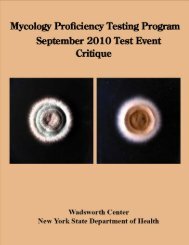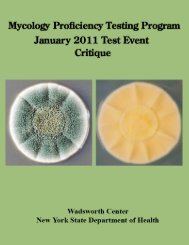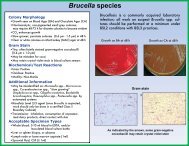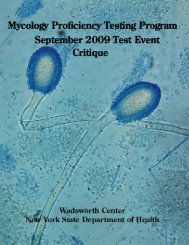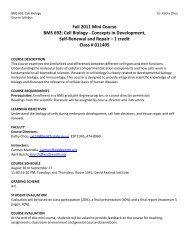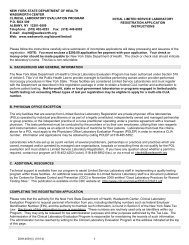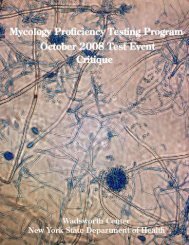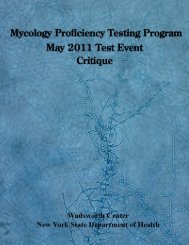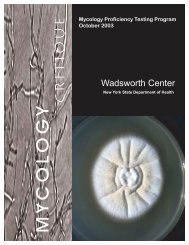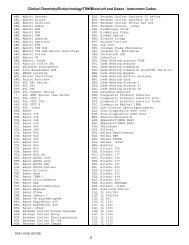September 2007 - Wadsworth Center
September 2007 - Wadsworth Center
September 2007 - Wadsworth Center
You also want an ePaper? Increase the reach of your titles
YUMPU automatically turns print PDFs into web optimized ePapers that Google loves.
M-2 Acremonium sp.Source: ToeScoring:No. LaboratoriesReferee Laboratories with correct ID: 10Laboratories with correct ID: 75Laboratories with incorrect ID: 2(Aureobasidium pullulans) (1)(Trichophyton terrestre) (1)Clinical Significance: Acremonium sp. causes onychomycosis, keratitis, endophthalmitis, endocarditis,meningitis, peritonitis, and osteomyelitis, especially in immunocompromised patients.Ecology: Acremonium sp. is cosmopolitan in distribution, commonly isolated from plant debris and soil.Laboratory Diagnosis:1. Culture – Acremonium sp. grew moderately rapidly. The colony was powdery to velvety, white to palepink (Figure 3A). The reverse was pale to yellowish (Figure 3B).2. Microscopic morphology – Lactophenol cotton blue mount showed hyaline, fine and narrow septatehyphae, often in form of fascicle. Phialides were unbranched, solitary. Unicellular conidia accumulatedin heads at the apices of the phialides, oblong to ovoid (Figure 4).3. Differentiation from other molds – Acremonium species can be confused with certain non-macroconidiaproducing species of Fusarium and Verticillium strains, which produce solitary phialides. Both Fusariumand Verticillium spp. grow faster than Acremonium and produce deeply woolly colonies. Acremoniumspecies can be distinguished from Lecythophora and Phialemonium spp. by the presence of septabetween the base of phialides and hyphae. Gliomastix sp. is different from Acrmonium sp. by havingolive-green to greenish-black colonies and chains or balls of dark conidia.4. In vitro susceptibility testing – In general, Acremonium sp. is susceptible to amphotericin B, caspofungin,voriconazole, posaconazole, and itraconazole.5. Molecular tests – Internal transcribed spacer (ITS) regions can be used for Acremonium spp.identification.The identity of the test isolate was confirmed in Mycology PTP program by sequencing of its ITS1 andITS2 regions of rDNA. 100% identity was found between this PT specimen and Acremonium strictum UW580 (Genebank accession number: AY138848) for both ITS1 and ITS2 regions.Comments: One participating laboratory reported this specimen as Aureobasidium pullulans, which hasmucoid texture, becoming black with age; another laboratory reported it as Trichophyton terrestre, whichforms cylindrical macroconidia.Sequences alignment:Query 1 TCCGTAGGTGAACCTGCGGAGGGATCATTACCAGAGTGCCCTAGGCTCTCCAACCCATTG 60||||||||||||||||||||||||||||||||||||||||||||||||||||||||||||AY138848 1 TCCGTAGGTGAACCTGCGGAGGGATCATTACCAGAGTGCCCTAGGCTCTCCAACCCATTG 60Query 61 TGAACTTACCAAACGTTCCCTCGGCGGGCTCAGCGCGCGGTGGCCTCCGGGCCTCCGGGC 120||||||||||||||||||||||||||||||||||||||||||||||||||||||||||||AY138848 61 TGAACTTACCAAACGTTCCCTCGGCGGGCTCAGCGCGCGGTGGCCTCCGGGCCTCCGGGC 12015



